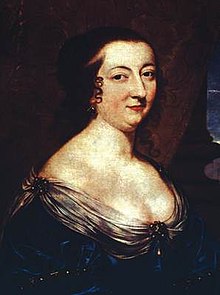Catherine de Vivonne, marquise de Rambouillet
Catherine de Vivonne | |
|---|---|
| marquise de Rambouillet | |
 (anonymous, 17th century) | |
| Born | 1588 Rome |
| Died | 2 December 1665 |
| Spouse(s) | Marquis de Rambouillet |
| Father | Jean de Vivonne |
| Mother | Giulia Savelli |
Catherine de Vivonne, marquise de Rambouillet (1588 – 2 December 1665), known as Madame de Rambouillet, was a society hostess and a major figure in the literary history of 17th-century France.
| French and Francophone literature |
|---|
| by category |
| History |
| Movements |
| Writers |
| Countries and regions |
|
| Portals |
Life
Born in Rome, she was the daughter and heiress of Jean de Vivonne, marquis of Pisani, and Giulia Savelli, who belonged to a noble Roman family. She was married at the age of twelve to
Madame de Rambouillet arranged the former Hôtel Pisani for the purpose of receiving her guests, and devised suites of small rooms where guests could move around and find more privacy than in the large reception rooms. She received her visitors in the chambre bleue, a salon painted in blue and with blue heavy brocade wall hangings.
Her success as a literary hostess (the term salonnière did not appear before the 19th century) has many explanations. Her natural abilities had been carefully trained. The marquise had a genuine kindness and a lack of prejudice that enabled her to entertain princes and princesses of the blood royal and literary men with the same grace, whilst among her intimate friends was the actress Angélique Paulet. The respect paid to ability in the salon effected a great advancement in the position of French men of letters. Moreover, the almost uniform excellence of the memoirs and letters of 17th century French men and women may be traced largely to the development of conversation as a fine art at the Hôtel de Rambouillet, and the consequent establishment of a standard of clear and adequate expression. Mme de Rambouillet was known as the "incomparable Arthénice", the name being an anagram for "Catherine", devised by François de Malherbe and Racan.
Among the more noteworthy episodes in the history of the Hôtel de Rambouillet are the literary quarrel between the Uranistes and the Jobelins - respective partisans of two famous
The Précieuses, who are usually associated with Molière's avowed caricatures and with the extravagances of
Molière's immortal Précieuses ridicules was no doubt directly levelled not at the Hôtel de Rambouillet itself, but at the numerous coteries which in the course of years had sprung up in imitation of it. The satire affected the originators as well as the imitators, the former more closely perhaps than they perceived. The Hôtel de Rambouillet remained in existence until the death of its hostess, although the troubles of the
The chief original authorities respecting Madame de Rambouillet and her set are Tallemant des Réaux in his Historiettes, and Antoine Baudeau de Somaize in his Grand Dictionnaire des Précieuses (1660).

Among the habitués of Madame de Rambouillet's chambre bleue were:
- Jean-Louis Guez de Balzac
- Le Grand Condé
- Anne Geneviève de Bourbon, duchesse de Longueville
- Anne Marie Louise d'Orléans, Duchesse de Montpensier, La Grande Mademoiselle
- Honorat de Bueil, seigneur de Racan
- Roger de Bussy-Rabutin
- Jean Chapelain
- Claude de Chaudebonne
- Guillaume Colletet
- Valentin Conrart
- Pierre Corneille
- Jean Desmarets de Saint-Sorlin
- Claude Favre de Vaugelas
- Antoine Girard de Saint-Amant
- Antoine Godeau
- Madame de La Fayette
- Jean de La Fontaine
- François de Malherbe
- Claude de Malleville
- François Maynard
- Gilles Ménage
- Jean Ogier de Gombauld
- Angélique Paulet
- Madame de Sévigné
- Charles de Sainte-Maure, duc de Montausier
- Paul Scarron
- Georges de Scudéry
- Madeleine de Scudéry
- Gédéon Tallemant des Réaux
- Vincent Voiture
In homage to the Marquise de Rambouillet, the city of Rambouillet has named its Junior High School Collège Catherine de Vivonne.[7]
See also
References
- ^ G. Lenotre, Le Château de Rambouillet, six siècles d'histoire, chapter: Les Précieuses, Denoël, Paris, 1984, p. 19.
- ^ Map of Paris by N. de Fer, dated 1705, on which the rue Saint-Thomas du Louvre, which disappeared in the mid-19th century, can be seen between the Louvre and the Tuileries: fr:Fichier:Plan de Paris 1705 BNF07710700.png
- ^ Tallemant des Réaux Historiettes, chapter Madame de Rambouillet, "Mémoires" reviewed by MM. Monmerqué & Paulin, (3rd edition), published by J. Techener, Libraire, Paris, 1862, tome 2, p. 262.[1]
- ^ Inventaires de l'hôtel de Rambouillet à Paris en 1652, 1666 et 1671, du château de Rambouillet en 1666 et des châteaux d'Angoulême et de Montauriser en 1671, publiés par Charles Sauzé, Magistrat, pour la Société archéologique de Rambouillet, avec une Préface de F. Lorin, Secrétaire de cette Société, N° XX de ses Publications, Tours, Imprimerie Deslis Frères, 6 rue Gambetta, 1894, p. 39
- ^ Tallemant des Réaux, p. 265
- ^ G. Lenotre, pp. 24-25.
- ^ "Collège Catherine de Vivonne, RAMBOUILLET - Inspection de l'Education nationale de RAMBOUILLET".
- Attribution
- This article incorporates text from a publication now in the public domain: Chisholm, Hugh, ed. (1911). "Rambouillet, Catherine de Vivonne, Marquise de". Encyclopædia Britannica. Vol. 22 (11th ed.). Cambridge University Press. pp. 873–874.
